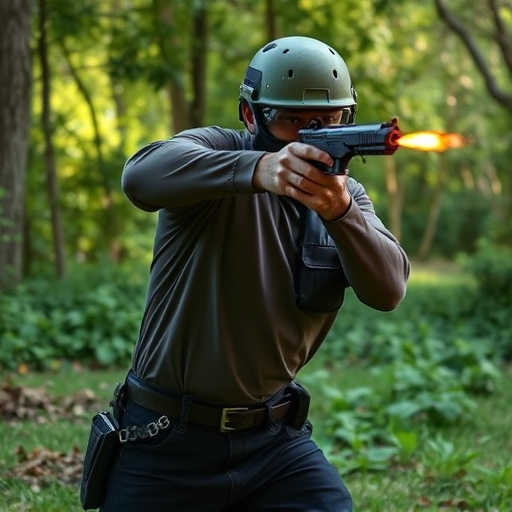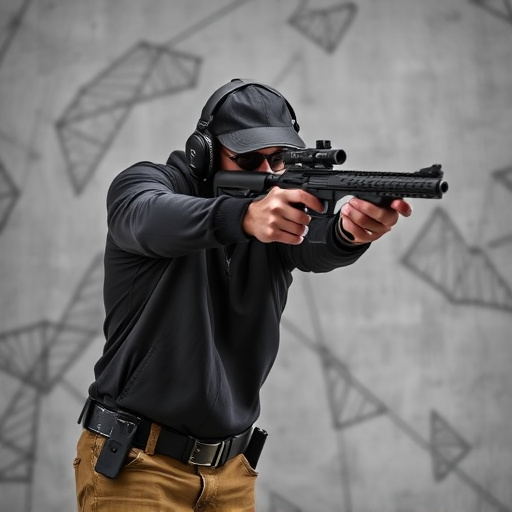Stun guns (electronic control devices) impair nerve signals between the brain and muscles, causing temporary symptoms like muscle twitching and dizziness. Effective stun guns balance high voltage and low current with safety features such as range, activation mechanism, size, durability, and water resistance. Responsible use involves training, secure storage, adhering to legal regulations, and employing them only as a last resort against imminent threats.
“Explore the world of non-lethal self-protection devices, focusing on their key specifications and the science behind stun guns. This article delves into the fascinating dynamics of how these tools affect the nervous system, offering insights into their functionality and impact. We break down essential considerations for effective protection, safety measures, and legal implications, ensuring informed decisions in choosing responsible self-defense options. Uncover the power of stun guns and their effects on the nervous system while navigating the important aspects of their use.”
- Understanding Stun Gun Functionality and Its Impact on the Nervous System
- Key Specifications to Consider for Effective Non-Lethal Self-Protection Devices
- Safety Measures and Legal Implications: Ensuring Responsible Use of Stun Guns
Understanding Stun Gun Functionality and Its Impact on the Nervous System

Stun guns, also known as electronic control devices (ECDs), operate by delivering a powerful electric shock to temporarily incapacitate a target. Their primary function is to disrupt muscle control and coordination by targeting the nervous system. When activated, the stun gun emits a high-voltage, low-amperage electrical pulse that interferes with the nerve signals between the brain and the muscles, causing them to spasm and relax rapidly. This sudden disruption leads to a loss of balance, disorientation, and temporary paralysis, allowing the user to escape or render an assailant non-threatening.
The impact on the nervous system is rapid and intense but typically non-lethal. The shock can cause symptoms such as muscle twitching, nausea, dizziness, and in some cases, brief loss of consciousness. However, these effects are designed to be short-lived, wearing off within seconds to minutes, after which the individual becomes fully functional again. Understanding the stun gun’s mechanism and its precise effects on the nervous system is crucial for users to appreciate both its effectiveness as a self-defense tool and its limitations in ensuring user safety.
Key Specifications to Consider for Effective Non-Lethal Self-Protection Devices

When it comes to non-lethal self-protection devices, several key specifications determine their effectiveness. Firstly, consider the stun gun’s electrical output. A higher voltage and current can deliver more intense stun gun effects on the nervous system, ensuring a swift incapacitation. However, this must be balanced with safety to prevent collateral damage or harm to bystanders.
Another crucial aspect is the device’s range and activation mechanism. A longer range allows for distance-based protection, while quick activation ensures immediate response time during an attack. Additionally, weight and size play a role in usability; lighter, more compact devices are easier to carry and deploy discreetly. Moreover, durability and water resistance are essential features to consider, as they enhance the device’s reliability in various environments.
Safety Measures and Legal Implications: Ensuring Responsible Use of Stun Guns

The responsible use of non-lethal self-protection devices, such as stun guns, is paramount to ensuring safety and mitigating potential risks. Stun guns temporarily incapacitate an assailant by disrupting their nervous system, causing intense pain and muscular spasms. This effect is achieved through high voltage electrical discharge, which does not cause permanent harm but requires careful handling to prevent accidental injuries or misuse.
Legal implications surrounding stun gun ownership and use vary across jurisdictions, with many countries and states implementing specific regulations. Users must understand local laws regarding stun gun possession, permit requirements, and the circumstances under which they can be employed for self-defense. Responsible users also adhere to safety guidelines, including proper training, secure storage, and only deploying the device as a last resort when facing an imminent threat.
Non-lethal self-protection devices, such as stun guns, offer a crucial option for personal safety without causing permanent harm. By understanding their impact on the nervous system and selecting devices with appropriate specifications, users can ensure effective protection while adhering to legal guidelines. Responsible use, combined with proper training, makes these tools valuable assets in navigating potential threats.
